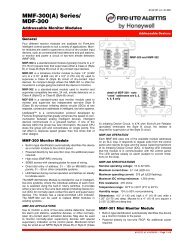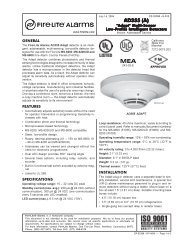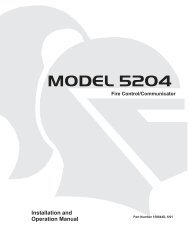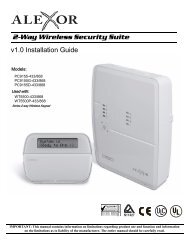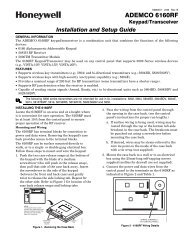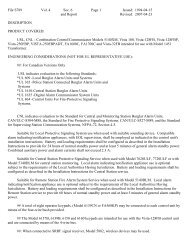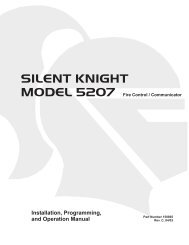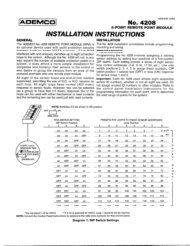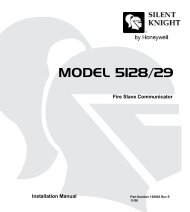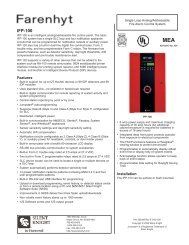ADEMCO LYNXR Series Security Systems - Patriot Alarm Systems ...
ADEMCO LYNXR Series Security Systems - Patriot Alarm Systems ...
ADEMCO LYNXR Series Security Systems - Patriot Alarm Systems ...
Create successful ePaper yourself
Turn your PDF publications into a flip-book with our unique Google optimized e-Paper software.
RECOMMENDATIONS FOR PROPER PROTECTION<br />
The Following Recommendations for the Location of Fire and Burglary Detection Devices Help Provide<br />
Proper Coverage for the Protected Premises.<br />
Recommendations for Smoke and Heat Detectors<br />
With regard to the number and placement of smoke/heat detectors, we subscribe to the recommendations<br />
contained in the National Fire Protection Association's (NFPA) Standard #72 noted below.<br />
• Early warning fire detection is best achieved by the installation of fire detection equipment in all rooms and areas of<br />
the household as follows: For minimum protection a smoke detector should be installed outside of each separate sleeping<br />
area, and on each additional floor of a multi-floor family living unit, including basements. The installation of smoke<br />
detectors in kitchens, attics (finished or unfinished), or in garages is not normally recommended.<br />
• For additional protection the NFPA recommends that you install heat or smoke detectors in the living room, dining<br />
room, bedroom(s), kitchen, hallway(s), attic, furnace room, utility and storage rooms, basements and attached garages.<br />
In addition, we recommend the following:<br />
• Install a smoke detector inside every bedroom where a smoker sleeps.<br />
• Install a smoke detector inside every bedroom where someone sleeps with the door partly or completely closed. Smoke<br />
could be blocked by the closed door. Also, an alarm in the hallway outside may not wake up the sleeper if the door is<br />
closed.<br />
• Install a smoke detector inside bedrooms where electrical appliances (such as portable heaters, air conditioners or<br />
humidifiers) are used.<br />
• Install a smoke detector at both ends of a hallway if the hallway is more than 40 feet (12 meters) long.<br />
• Install smoke detectors in any room where an alarm control is located, or in any room where alarm control connections<br />
to an AC source or phone lines are made. If detectors are not so located, a fire within the room could prevent the control<br />
from reporting a fire or an intrusion.<br />
THIS CONTROL COMPLIES WITH NFPA REQUIREMENTS FOR TEMPORAL PULSE<br />
SOUNDING OF FIRE NOTIFICATION APPLIANCES.<br />
DINING<br />
KITCHEN<br />
BEDROOM<br />
BEDROOM<br />
TV ROOM<br />
KITCHEN<br />
DINING<br />
LIVING ROOM<br />
BEDROOM<br />
BEDROOM<br />
LIVING ROOM<br />
BEDROOM<br />
BEDROOM<br />
Smoke Detectors for Minimum Protection<br />
Smoke Detectors for Additional Protection<br />
BEDROOM<br />
Heat-Activated Detectors<br />
BEDROOM<br />
BEDROOM<br />
LIVING<br />
ROOM<br />
KTCHN<br />
.<br />
CLOSED<br />
DOOR<br />
GARAGE<br />
TO<br />
BEDROOM<br />
BASEMENT<br />
01000-002-V0<br />
Recommendations For Proper Intrusion Protection<br />
• For proper intrusion coverage, sensors should be located at every possible point of entry to a home or premises. This<br />
would include any skylights that may be present, and the upper windows in a multi-level building.<br />
• In addition, we recommend that radio backup be used in a security system. This will ensure that alarm signals can be<br />
sent to the alarm monitoring station in the event that the telephone lines are out of order (alarm signals are normally<br />
sent over the phone lines, if connected to an alarm monitoring station).<br />
–2–



